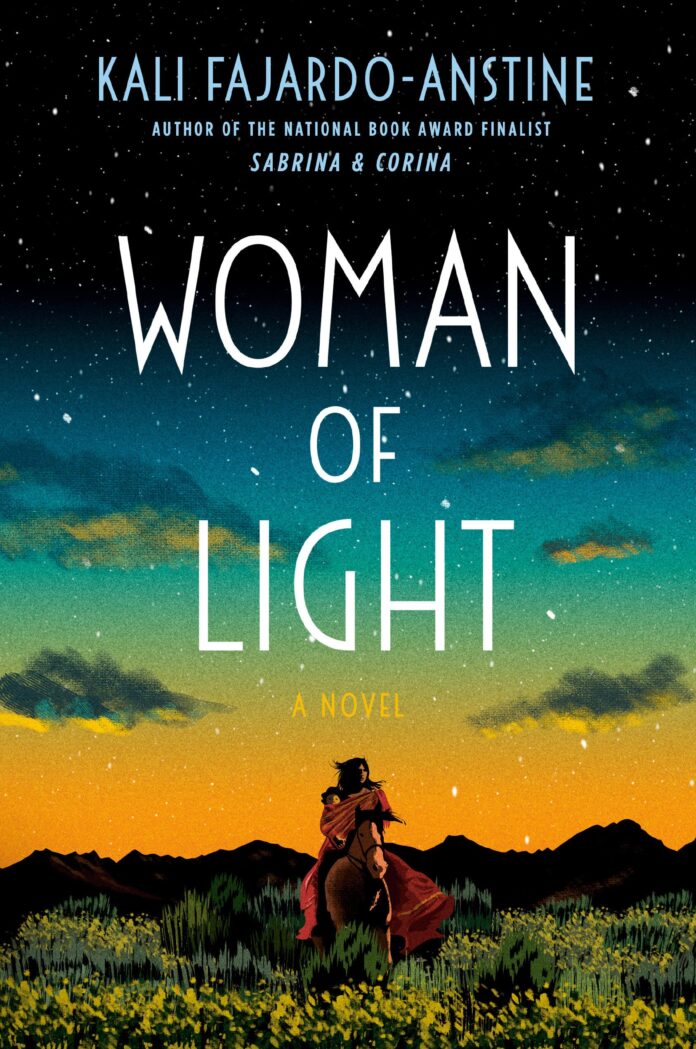In the ever-evolving tapestry of contemporary literature, tales woven from the threads of heritage and resilience resonate with an authenticity that lingers long after the final page. Kali Fajardo-Anstine’s “Woman of Light” emerges as a poignant exploration of identity, culture, and the enduring spirit of women navigating the complexities of their histories. Set against the vibrant backdrop of the American Southwest, this novel invites readers to journey alongside its richly drawn characters as thay traverse the intricate landscapes of family ties, love, and the weight of ancestral legacies. In this review, we will delve into the heart of Fajardo-Anstine’s narrative, examining how she masterfully intertwines personal and collective stories, ultimately illuminating the resilience that defines both individual lives and entire communities.
Exploring the Fabric of Identity Through Generations in Woman of Light
In ‘Woman of Light’, Kali Fajardo-Anstine delves into the intricate tapestry of identity, weaving together the experiences of a family across generations. The protagonist’s journey reveals how the past informs the present, showing that identity is not a static entity but rather a dynamic interplay of memory, culture, and resilience. The author beautifully captures the essence of heritage through vibrant storytelling, allowing the reader to understand how familial bonds shape and nurture the individual. The impact of traditions, stories shared around the fire, and the struggles faced in different historical contexts all serve to anchor the characters in their rich cultural legacy.
This exploration manifests through a series of interconnected narratives, each revealing a different facet of womanhood and cultural identity. The book highlights key elements such as:
- Generational Wisdom: Each character embodies the teachings of their ancestors, passing down knowledge that fortifies their sense of self.
- Struggles and Resilience: The characters face societal challenges that test their strength,revealing a profound connection to their roots.
- Cultural Fusion: The interplay of various influences showcases the evolution of identity within a historical context.
Such themes echo the idea that identity is not just inherited but continually reconstructed through lived experiences.Fajardo-anstine’s lyrical prose invites readers to reflect on their own familial histories, prompting questions about what elements they carry forward and how they shape their sense of self in a complex world.
An Immersive Journey into the Rich Cultural Tapestry of Chicanx Heritage
In ‘Woman of Light’, Kali Fajardo-Anstine encapsulates the essence of Chicanx heritage, weaving a narrative that reflects the intricate layers of cultural identity, familial bonds, and historical struggles. The story unfolds through the eyes of its protagonist, Based on their journey through the American West, exploring the intersection of indigenous and mexican traditions. Through rich descriptive language and vivid imagery, readers are transported to a world where the desert landscape mirrors the characters’ inner turmoil and resilience. The author highlights the importance of ancestry and its profound influence on contemporary life, showcasing how generations of women have shaped their identities against the backdrop of socio-political challenges.
Central to the narrative is the theme of resilience, which emerges from the characters’ experiences and the historical contexts they navigate. Fajardo-Anstine describes their emotional journeys with a sense of authenticity, creating relatable connections for readers. The book not only offers a party of Chicanx traditions but also addresses contemporary issues faced by the community,such as displacement,identity struggles,and cultural pride.By intertwining personal stories with collective history, the author presents Chicanx culture as a living tapestry, vibrant and dynamic, inviting readers to reflect on their own heritage and the strength that comes from understanding one’s roots.
Resilience as a Central theme in Kali Fajardo-Anstine’s narrative Craft
Kali Fajardo-Anstine weaves a rich tapestry of resilience throughout Woman of Light, portraying characters who navigate the complexities of identity and belonging within a landscape marked by cultural heritage and personal struggle. Central to this narrative is the intergenerational strength exhibited by her characters, which serves as a testament to their ability to endure and thrive despite adversities. The interplay of historical trauma and personal revelation highlights how the characters draw upon their past to forge a path forward. tales of migration, loss, and reconciliation form a backdrop against which resilience emerges as a vital force, guiding each character’s journey and illuminating their connections to ancestry and place.
The narrative unfolds in a world that intricately links place and identity, exposing how the characters embody the resilience of their ancestors. fajardo-Anstine’s portrayal of their struggles encourages readers to reflect on the significance of community and tradition in shaping individual strength. This is further emphasized through moments of sisterhood and friendship, where characters support one another in their quests for self-acceptance. Through her characters’ journeys, the novel illustrates that resilience is not a solitary endeavor; it is a shared experience, fostered through bonds that transcend time and challenges. These themes resonate deeply, inviting readers to explore their own connections to resilience in the face of life’s trials.
The Balance of myth and Reality in Character development
The characters in Kali Fajardo-Anstine’s Woman of Light embody a rich tapestry of myth and reality, merging ancestral narratives with the struggles of contemporary life. Through the lens of cultural heritage, the protagonist navigates her personal journey while drawing strength from her family’s past. This fusion creates a vibrant backdrop that not only deepens character development but also resonates with readers on multiple levels. Themes of resilience are woven throughout the narrative, manifesting in the characters’ interpersonal relationships and their connection to the land, which serves as both a sanctuary and a battleground.
In illustrating their complexities, Fajardo-Anstine employs symbolism rooted in folklore, allowing the characters to transcend ordinary experiences. As readers delve into their stories, they are invited to consider the implications of myth in shaping identity. Notably, the balance between fantasy and realism in character arcs highlights the struggle for belonging in a world marked by displacement and disconnection. The following table succinctly captures the blend of myth and reality in each character’s journey:
| Character | Mythical Element | Real-world Struggle |
|---|---|---|
| Luz | Connection to the cosmos | Seeking her place in a fractured family |
| Papa | Ties to ancestral spirits | Surviving the hardships of migration |
| Mama | Guardian of tradition | confronting societal expectations for women |
Deep Dive into the Symbolism of Light and Its Multifaceted Meanings
In “Woman of Light,” light embodies not just physical illumination but a broader concept of hope and connection. Throughout the narrative, the use of light serves as a metaphor for cultural identity. Characters often seek refuge in its warmth, reflecting their yearning for belonging amid the challenges they face. This duality is illustrated through instances where the sun, moon, and stars are depicted as guiding forces, leading them toward spiritual and emotional revelations. The interplay of light also signifies transformation; moments of darkness are frequently contrasted with bursts of brightness, emphasizing resilience amid adversity.
Moreover, the symbolism of light extends deeply into the realm of memory and heritage. As the characters navigate their histories, light emerges as a conduit for recollection—a way for them to reconnect with their ancestors and the rich tapestry of their lineage. The connections formed through this symbolism resonate on multiple levels:
- Personal Growth: Each ray of light signifies an awakening of the inner self.
- cultural Legacy: Family stories illuminated through shared experiences.
- Community Bonds: The illumination of communal struggles and triumphs.
Female Empowerment and Interconnected Stories in Woman of Light
In “Woman of Light,” Kali Fajardo-Anstine weaves a rich tapestry of interconnected stories that place female empowerment at the forefront. Through the experiences of her protagonist, Luz, and the strong women who shape her lineage, the narrative highlights the strength derived from shared experiences. Each character embodies resilience, navigating the complexities of their heritage and the challenges imposed by a society that often marginalizes them. Their stories illuminate how, despite adversity, women find strength in community, standing together to reclaim their identities and histories. The author masterfully illustrates that empowerment is not merely an individual pursuit; it is cultivated through the bonds of sisterhood and cultural solidarity.
The interconnected tales reveal various dimensions of female resilience—from cultural traditions passed down through generations to the personal struggles that define one’s journey. This multi-faceted exploration enables readers to engage with the material on a personal level, as they witness the characters challenge societal norms and expectations.Key themes emerge throughout the narrative, inviting reflection on how heritage and resilience intertwine to form a powerful foundation for empowerment. As an example, readers are compelled to consider questions such as:
- How do past experiences shape present identity?
- In what ways can women support each other’s journeys?
- What role does culture play in personal empowerment?
Ultimately, Fajardo-Anstine’s work serves as a poignant reminder of the transformative power of shared stories, inviting a deeper understanding of the collective strength found in women’s experiences across generations.
The Role of Landscape in Shaping the Characters and Their stories
In Kali Fajardo-Anstine’s Woman of Light, the rugged landscapes of the American West serve as a profound backdrop that not only influences the narrative but also plays a pivotal role in the development of its characters. The setting is not merely a stage; rather, it acts as a living entity that shapes the protagonists’ identities and struggles.Desolate deserts, shadowy mountains, and bustling towns interweave with the complexities of heritage and resilience, allowing characters such as Luz to navigate their pasts while confronting their present. This dynamic relationship with the landscape emphasizes their connection to roots and ancestry, teasing out the beauty amid hardship and highlighting how the habitat can sculpt one’s character traits and choices.
Moreover, the vibrant depiction of the natural world reveals intricacies within the characters’ interpersonal relationships. The stark contrasts between the arid earth and the lush moments of personal growth signify emotional landscapes that resonate throughout the storyline. As characters traverse these geographical realms,they are forced to contend with themes of displacement,cultural identity,and the enduring spirit of their lineage. This interplay suggests that the land is not just a physical location but a vessel of stories, echoing the resilience of those who inhabit it. The imagery of the landscapes—marked by beauty and peril—creates a multifaceted narrative that immerses readers into the lives shaped by their surroundings.
A Unique Perspective on Family Dynamics and interpersonal Relationships
In Kali Fajardo-Anstine’s “Woman of Light,” the intricacies of family dynamics unfold in a tapestry woven from threads of heritage, resilience, and cultural identity. The story intricately depicts the intergenerational bonds that not only sustain but also shape the characters of the novel. Through the experiences of its protagonist, we gain insight into how familial connections are both a source of strength and a catalyst for tension. The influence of migration,personal histories,and shared traditions illuminates the profound impact these elements have on interpersonal relationships. Themes of strength and fragility coexist, revealing the complexities of love and loyalty in the face of adversity.
Moreover, the author skillfully juxtaposes the individual struggles against the backdrop of a rich cultural landscape, creating a narrative that resonates with global truths about human connection. The characters’ journeys highlight critically important aspects of family life, including:
- Conflict Resolution: Navigating disagreements that arise from differing values and life choices.
- Legacy: The ways in which past generations influence present lives and decisions.
- Support Systems: How mutual aid and understanding strengthen familial ties.
This nuanced exploration of relationships not only captures the essence of familial love but also reflects the resilience required to maintain these bonds amidst life’s challenges. Fajardo-Anstine’s work invites readers to reflect on their own connections while appreciating the diversity of experiences that define family.
Empathy and Emotion: How the Prose Connects with Readers
In “Woman of Light,” Kali Fajardo-Anstine weaves a rich tapestry of emotion that resonates deeply with readers, allowing them to traverse the landscapes of cultural identity, familial bonds, and personal resilience. The prose is imbued with a profound empathy that reveals the struggles and triumphs of its characters. Readers find themselves immersed in the lived experiences of the protagonists, experiencing their love, pain, and growth in a way that feels achingly familiar. The author masterfully employs vivid imagery and poignant metaphors that evoke not only the physical elements of the setting but also the emotional undercurrents that shape the characters’ journeys.
the connection that emerges between the narrative and the audience is amplified through Fajardo-Anstine’s ability to articulate complex emotions with clarity and resonance. By addressing themes such as heritage and resilience, she invites readers to reflect on their own stories and the collective history that binds them. This storytelling not only cultivates an understanding of the characters’ struggles but also fosters a sense of shared humanity, prompting readers to engage with their own heritage and the resilience that lies within. The interplay of emotional depth and relatable experiences creates a space where readers can genuinely empathize with the characters, making the novel not just a tale of fiction but a mirror reflecting their own lives.
Echoes of History: the Impact of Place on Personal Narratives
Kali Fajardo-Anstine’s ‘Woman of Light’ intricately weaves personal narratives against the rich tapestry of place, revealing how the landscape of the American Southwest serves as both a backdrop and a character in its own right. The novel beautifully illustrates that locations like Denver’s vibrant neighborhoods and the arid stretches of the desert are not merely settings, but active participants in shaping the identities and experiences of the characters. Through the lens of the protagonist, we witness how familial ties and collective memories are nurtured by the earth beneath their feet, echoing generations of resilience and cultural heritage. The author’s lyrical descriptions evoke a profound sense of belonging, as characters like Luz navigate their historical and cultural landscapes, uncovering truths about themselves and their ancestral roots.
Furthermore, the interplay between environment and narrative in ‘woman of Light’ emphasizes the importance of place as a catalyst for personal evolution. As Luz confronts challenges steeped in systemic inequities and personal turmoil, the very geography that surrounds her becomes a source of strength and inspiration. The novel captures how the traditions of the Hispanic community and the struggles of immigrant life interlace, illustrating a nuanced understanding of identity formed through the interplay of societal forces and natural landscapes. This multifaceted relationship prompts readers to reflect on their own experiences and the environments that mold their stories, fostering an understanding that our narratives are inextricably linked to the places we inhabit.
Layered Emotions: Analyzing the Complex Interactions of Characters
Kali Fajardo-Anstine’s “Woman of Light” intricately weaves a tapestry of emotions,presenting characters whose lives are steeped in cultural heritage and personal struggle. The protagonist, Luz, embodies the tension between her indigenous ancestry and the modern world, creating a rich internal conflict as she navigates familial expectations and societal pressures. Through her journey, readers encounter a host of supporting characters, each contributing to the emotional landscape. They grapple with their shared history, including:
- Loss and Resilience: Characters confront their grief yet find strength in community.
- Identity and Belonging: Many question their place within their heritage and contemporary society.
- Love and Sacrifice: Relationships are tested as individuals weigh personal desires against cultural values.
This interplay of emotions not only reflects the complexities of the characters’ lives but also invites readers to reflect on their own experiences with heritage and identity. The nuanced relationships among the characters showcase how resilience is often born from shared struggles and collective support. utilizing a multifaceted narrative approach, Fajardo-Anstine skillfully creates a dialogue among generations, demonstrating that the past continually shapes the present. the strength of these characters lies in their layered interactions,revealing vulnerabilities and strengths that resonate deeply with readers. The evolution of Luz and her family members thus becomes a profound exploration of how cultural narratives influence personal journeys.
Insights on Societal Challenges and Cultural identity in Contemporary Context
Kali Fajardo-Anstine’s exploration of cultural identity through the lens of her characters highlights the complexities of heritage in a contemporary context. The narrative weaves together the legacies of Indigenous people and the challenges they face in maintaining their identity amid societal pressures. Characters grapple with their roots, navigating the fine line between tradition and modernity. This duality is essential, as it reflects the broader struggles of communities striving to honour their past while forging a path in a fast-evolving world. The tension between cultural preservation and the relentless pace of change becomes a poignant backdrop, resonating with readers who find themselves in similar situations.
The resilience displayed by Fajardo-Anstine’s characters serves as both an inspiration and a call to action. Through their journeys, we witness the power of community and the strength derived from a shared cultural narrative. The author meticulously illustrates the importance of storytelling, through which individuals reclaim their histories and assert their identities. This theme is underscored by the ways in which the characters fight against marginalization and strive for representation in a society that frequently enough overlooks their voices. The effect of such representation is significant, as it validates the experiences of those who feel caught between worlds and exemplifies the rich tapestry of contemporary cultural identity.
Narrative techniques that Elevate the Reader’s Experience
In ‘Woman of Light’, Kali Fajardo-Anstine employs a rich tapestry of narrative techniques that not only enhance the storyline but also immerse the reader into the multifaceted world of her characters. Through the use of vivid imagery, she paints striking visual scenes that bring the landscapes of the American Southwest and the intricacies of communal life to life. The narrative flows seamlessly between time periods, intertwining the past with the present, allowing the reader to understand the historical context that shapes the characters’ identities. This non-linear approach engages the audience, inviting them to piece together fragmented stories into a cohesive whole, much like the patchwork of heritage the characters navigate.
Furthermore, the author’s masterful use of multiple perspectives adds depth to the narrative. By shifting between the viewpoints of several characters, Fajardo-Anstine reveals the nuances of their experiences and the emotional weight they carry. This technique not only amplifies the themes of resilience and belonging but also fosters empathy in the reader. It encourages an introspective journey, asking readers to confront their perceptions of cultural identity and resilience. The artful detailing and multifaceted storytelling elevate the reader’s experience, ensuring that the lessons embedded within the narrative resonate long after the last page is turned.
Kali Fajardo-Anstine: the Voice Behind Woman of Light and Its cultural Significance
Kali Fajardo-Anstine masterfully interweaves personal history and cultural legacy in her novel, presenting a profound narrative that resonates deeply with the Chicano community and beyond. Through the eyes of her protagonist, Luz, readers journey through the vibrant landscapes of the American West, where the echoes of familial struggles and triumphs shape identity and belonging. Fajardo-Anstine’s storytelling captures the essence of cultural resilience, showcasing the daily realities and the unbreakable spirit of a community that has thrived despite systemic challenges. By centering female experiences and heritage, she provides a powerful lens through which readers can explore broader social themes, including migration, identity, and the fight for representation.
The novel also highlights the importance of intergenerational connections, where the wisdom and narratives of elders are passed down to the younger generations. Fajardo-Anstine crafts her characters with empathy, allowing them to articulate their struggles and dreams in a society that frequently enough marginalizes their voices. In doing so, she not only honors her own roots but also invites readers to confront and reflect on the complexities of their identities. The cultural significance embedded within the text serves as a reminder of the richness of heritage and the power of storytelling in reclaiming one’s narrative. Below is a brief overview of the key themes explored in ’Woman of Light’:
| Key Themes | Description |
|---|---|
| Heritage | Exploration of identity through family stories. |
| Resilience | Coping with adversity and celebrating strength. |
| feminism | Focus on the female experience and empowerment. |
| Belonging | Search for place within society. |
To Conclude
“Woman of Light” by Kali Fajardo-Anstine stands as a poignant testament to the complexities of heritage, identity, and resilience. through the vivid tapestry of her characters and their interwoven narratives, Fajardo-Anstine invites readers to traverse both the physical landscapes of the American west and the emotional landscapes of cultural belonging. The blend of historical context with personal struggle creates a rich dialogue about the intricacies of lineage and the strength derived from it. As we reflect on the stories of Luz and her family, we’re reminded of the profound connections that bind us to our past while propelling us toward the future.This novel is not just a story to be read; it is an experience to be felt, sparking conversations about the enduring power of heritage in shaping the human spirit. Whether you’re seeking a deep, immersive read or a glimpse into the resilience of marginalized voices, ”Woman of Light” is a luminous addition to contemporary literature that will linger long after the final page is turned.

















